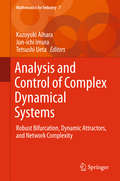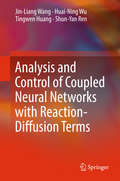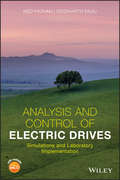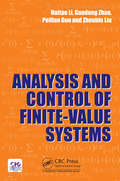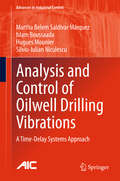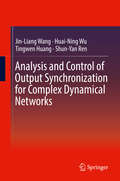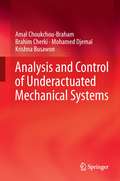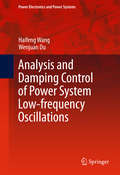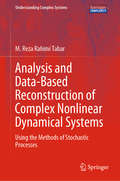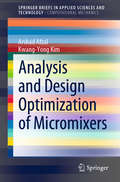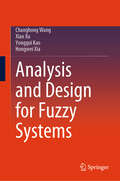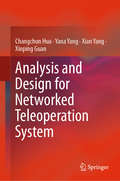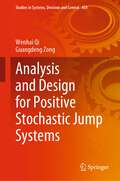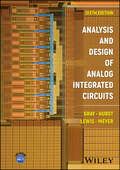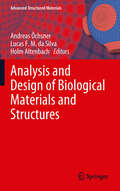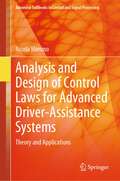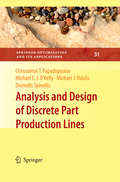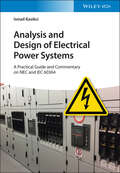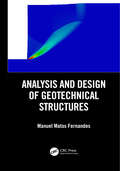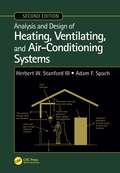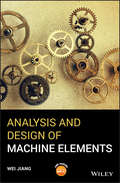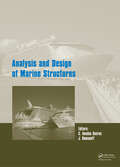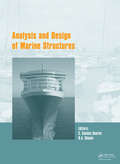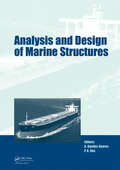- Table View
- List View
Analysis and Control of Complex Dynamical Systems: Robust Bifurcation, Dynamic Attractors, and Network Complexity (Mathematics for Industry #7)
by Tetsushi Ueta Kazuyuki Aihara Jun-Ichi ImuraThis book is the first to report on theoretical breakthroughs on control of complex dynamical systems developed by collaborative researchers in the two fields of dynamical systems theory and control theory. As well, its basic point of view is of three kinds of complexity: bifurcation phenomena subject to model uncertainty, complex behavior including periodic/quasi-periodic orbits as well as chaotic orbits, and network complexity emerging from dynamical interactions between subsystems. Analysis and Control of Complex Dynamical Systems offers a valuable resource for mathematicians, physicists, and biophysicists, as well as for researchers in nonlinear science and control engineering, allowing them to develop a better fundamental understanding of the analysis and control synthesis of such complex systems.
Analysis and Control of Coupled Neural Networks with Reaction-Diffusion Terms
by Tingwen Huang Jin-Liang Wang Huai-Ning Wu Shun-Yan RenThis book introduces selected recent findings on the analysis and control of dynamical behaviors for coupled reaction-diffusion neural networks. It presents novel research ideas and essential definitions concerning coupled reaction-diffusion neural networks, such as passivity, adaptive coupling, spatial diffusion coupling, and the relationship between synchronization and output strict passivity. Further, it gathers research results previously published in many flagship journals, presenting them in a unified form. As such, the book will be of interest to all university researchers and graduate students in Engineering and Mathematics who wish to study the dynamical behaviors of coupled reaction-diffusion neural networks.
Analysis and Control of Electric Drives: Simulations and Laboratory Implementation
by Ned Mohan Siddharth RajuA guide to drives essential to electric vehicles, wind turbines, and other motor-driven systems Analysis and Control of Electric Drives is a practical and comprehensive text that offers a clear understanding of electric drives and their industrial applications in the real-world including electric vehicles and wind turbines. The authors—noted experts on the topic—review the basic knowledge needed to understand electric drives and include the pertinent material that examines DC and AC machines in steady state using a unique physics-based approach. The book also analyzes electric machine operation under dynamic conditions, assisted by Space Vectors. The book is filled with illustrative examples and includes information on electric machines with Interior Permanent Magnets. To enhance learning, the book contains end-of-chapter problems and all topics covered use computer simulations with MATLAB Simulink® and Sciamble® Workbench software that is available free online for educational purposes. This important book: Explores additional topics such as electric machines with Interior Permanent Magnets Includes multiple examples and end-of-chapter homework problems Provides simulations made using MATLAB Simulink® and Sciamble® Workbench, free software for educational purposes Contains helpful presentation slides and Solutions Manual for Instructors; simulation files are available on the associated website for easy implementation A unique feature of this book is that the simulations in Sciamble® Workbench software can seamlessly be used to control experiments in a hardware laboratory Written for undergraduate and graduate students, Analysis and Control of Electric Drives is an essential guide to understanding electric vehicles, wind turbines, and increased efficiency of motor-driven systems.
Analysis and Control of Finite-Valued Systems
by Guodong Zhao Haitao Li Peilian GuoA comprehensive work in finite-value systems that covers the latest achievements using the semi-tensor product method, on various kinds of finite-value systems. These results occupy the highest position in the analysis and control of this field. It not only covers all aspects of research in finite-value systems, but also presents the mathematical derivation for each conclusion in depth. The book contains examples to provide a better understanding of the practical applications of finite-value systems. It will serve as a textbook for graduate students of Cybernetics, Mathematical, and Biology, and a reference for readers interested in the theory of finite-value systems.
Analysis and Control of Oilwell Drilling Vibrations: A Time-Delay Systems Approach (Advances in Industrial Control)
by Silviu-Iulian Niculescu Hugues Mounier Martha Belem Saldivar Márquez Islam BoussaadaThis book reports the results of exhaustive research work on modeling and control of vertical oil well drilling systems. It is focused on the analysis of the system-dynamic response and the elimination of the most damaging drill string vibration modes affecting overall perforation performance: stick-slip (torsional vibration) and bit-bounce (axial vibration). The text is organized in three parts. The first part, Modeling, presents lumped- and distributed-parameter models that allow the dynamic behavior of the drill string to be characterized; a comprehensive mathematical model taking into account mechanical and electric components of the overall drilling system is also provided. The distributed nature of the system is accommodated by considering a system of wave equations subject to nonlinear boundary conditions; this model is transformed into a pair of neutral-type time-delay equations which can overcome the complexity involved in the analysis and simulation of the partial differential equation model. The second part, Analysis, is devoted to the study of the response of the system described by the time-delay model; important properties useful for analyzing system stability are investigated and frequency- and time-domain techniques are reviewed. Part III, Control, concerns the design of stabilizing control laws aimed at eliminating undesirable drilling vibrations; diverse control techniques based on infinite--dimensional system representations are designed and evaluated. The control proposals are shown to be effective in suppressing stick-slip and bit-bounce so that a considerable improvement of the overall drilling performance can be achieved. This self-contained book provides operational guidelines to avoid drilling vibrations. Furthermore, since the modeling and control techniques presented here can be generalized to treat diverse engineering problems, it constitutes a useful resource to researchers working on control and its engineering application in oil well drilling.
Analysis and Control of Output Synchronization for Complex Dynamical Networks
by Tingwen Huang Jin-Liang Wang Huai-Ning Wu Shun-Yan RenThis book introduces recent results on output synchronization of complex dynamical networks with single and multiple weights. It discusses novel research ideas and a number of definitions in complex dynamical networks, such as H-Infinity output synchronization, adaptive coupling weights, multiple weights, the relationship between output strict passivity and output synchronization. Furthermore, it methodically edits the research results previously published in various flagship journals and presents them in a unified form. The book is of interest to university researchers and graduate students in engineering and mathematics who wish to study output synchronization of complex dynamical networks.
Analysis and Control of Underactuated Mechanical Systems
by Amal Choukchou-Braham Brahim Cherki Mohamed Djemaï Krishna BusawonThis monograph provides readers with tools for the analysis, and control of systems with fewer control inputs than degrees of freedom to be controlled, i. e. , underactuated systems. The text deals with the consequences of a lack of a general theory that would allow methodical treatment of such systems and the ad hoc approach to control design that often results, imposing a level of organization whenever the latter is lacking. The authors take as their starting point the construction of a graphical characterization or control flow diagram reflecting the transmission of generalized forces through the degrees of freedom. Underactuated systems are classified according to the three main structures by which this is found to happen--chain, tree, and isolated vertex--and control design procedures proposed. The procedure is applied to several well-known examples of underactuated systems: acrobot; pendubot; Tora system; ball and beam; inertia wheel; and robotic arm with elastic joint. ®/Simulink® simulations that demonstrate the effectiveness of the methods detailed. Readers interested in aircraft, vehicle control or various forms of walking robot will be able to learn from Underactuated Mechanical Systems how to estimate the degree of complexity required in the control design of several classes of underactuated systems and proceed on to further generate more systematic control laws according to its methods of analysis.
Analysis and Damping Control of Power System Low-frequency Oscillations: Linear Methods (Power Electronics and Power Systems)
by Haifeng Wang Wenjuan DuThis book presents the research and development results on power systems oscillations in three categories of analytical methods. First is damping torque analysis which was proposed in 1960's, further developed between 1980-1990, and widely used in industry. Second is modal analysis which developed between the 1980's and 1990's as the most powerful method. Finally the linearized equal-area criterion analysis that is proposed and developed recently. The book covers three main types of controllers: Power System Stabilizer (PSS), FACTS (Flexible AC Transmission Systems) stabilizer, and ESS (Energy Storage Systems) stabilizer. The book provides a systematic and detailed introduction on the subject as the reference for industry applications and academic research.
Analysis and Data-Based Reconstruction of Complex Nonlinear Dynamical Systems: Using the Methods of Stochastic Processes (Understanding Complex Systems)
by M. Reza Rahimi TabarThis book focuses on a central question in the field of complex systems: Given a fluctuating (in time or space), uni- or multi-variant sequentially measured set of experimental data (even noisy data), how should one analyse non-parametrically the data, assess underlying trends, uncover characteristics of the fluctuations (including diffusion and jump contributions), and construct a stochastic evolution equation?Here, the term "non-parametrically" exemplifies that all the functions and parameters of the constructed stochastic evolution equation can be determined directly from the measured data.The book provides an overview of methods that have been developed for the analysis of fluctuating time series and of spatially disordered structures. Thanks to its feasibility and simplicity, it has been successfully applied to fluctuating time series and spatially disordered structures of complex systems studied in scientific fields such as physics, astrophysics, meteorology, earth science, engineering, finance, medicine and the neurosciences, and has led to a number of important results.The book also includes the numerical and analytical approaches to the analyses of complex time series that are most common in the physical and natural sciences. Further, it is self-contained and readily accessible to students, scientists, and researchers who are familiar with traditional methods of mathematics, such as ordinary, and partial differential equations.The codes for analysing continuous time series are available in an R package developed by the research group Turbulence, Wind energy and Stochastic (TWiSt) at the Carl von Ossietzky University of Oldenburg under the supervision of Prof. Dr. Joachim Peinke. This package makes it possible to extract the (stochastic) evolution equation underlying a set of data or measurements.
Analysis and Design Optimization of Micromixers (SpringerBriefs in Applied Sciences and Technology)
by Kwang-Yong Kim Arshad AfzalThis book illustrates the computational framework based on knowledge of flow and mass transfer together with optimization techniques to solve problems relevant to micromixing technology. The authors provide a detailed analysis of the different numerical techniques applied to the design of micromixers. Flow and mixing analysis is based on both the Eulerian and Lagrangian approaches; relative advantages and disadvantages of the two methods and suitability to different types of mixing problems are analysed. The book also discusses the various facets of numerical schemes subjected to discretization errors and computational grid requirements. Since a large number of studies are based on commercial computational fluid dynamics (CFD) packages, relevant details of these packages to the mixing problem using them are presented. Numerical optimization techniques coupled with CFD analysis of flow and mixing have proved to be an important tool for micromixers design, and therefore, are an important part of the book. These techniques are presented briefly, and focus is on surrogate modeling and optimization applied to design of micromixers.
Analysis and Design for Fuzzy Systems
by Yonggui Kao Changhong Wang Hongwei Xia Xiao XuThis book proposes analysis and design techniques for fuzzy systems using adaptive technology, event triggering mechanism, sampling control technology, and sliding mode control technology. The book covers stochastic stability, finite-time boundedness, actuator failure problems, fault-tolerant control, asynchronous control, and adaptive sliding mode control for uncertain fuzzy systems. The topic of fault-tolerant control will be of particular interest to readers because: (i) the internal hardware components of the system may age and fail to a greater or lesser extent; (ii) the external environment may suddenly change. With illustrations and tables, readers can easily follow the didactic approach and apply the methods to their own research. This book will be of particular interest to researchers and graduate students in control engineering and applied mathematics who are interested in the latest developments in fuzzy systems.
Analysis and Design for Networked Teleoperation System
by Changchun Hua Xinping Guan Yana Yang Xian YangThis book presents cutting-edge results on stability analysis and control scheme designs for networked teleoperation systems. It highlights new research on commonly encountered nonlinear teleoperation systems, including the stability analysis of teleoperation systems with asymmetric time-varying delays, stability analysis of teleoperation systems with interval time delays, and so on. Moreover, the book presents several high-performance control scheme designs for teleoperation systems when the velocity is available and unavailable, and for systems with nonlinear input. The results presented here mark a substantial contribution to nonlinear teleoperation system theory, robotic control theory and networked control system theory. As such, the book will be of interest to university researchers, R&D engineers and graduate students in control theory and control engineering who wish to learn about the core principles, methods, algorithms, and applications of networked teleoperation systems, robotic systems and nonlinear control systems.
Analysis and Design for Positive Stochastic Jump Systems (Studies in Systems, Decision and Control #450)
by Wenhai Qi Guangdeng ZongThe book focuses on analysis and design for positive stochastic jump systems. By using multiple linear co-positive Lyapunov function method and linear programming technique, a basic theoretical framework is formed toward the issues of analysis and design for positive stochastic jump systems. This is achieved by providing an in-depth study on several major topics such as stability, time delay, finite-time control, observer design, filter design, and fault detection for positive stochastic jump systems. The comprehensive and systematic treatment of positive systems is one of the major features of the book, which is particularly suited for readers who are interested to learn non-negative theory. By reading this book, the reader can obtain the most advanced analysis and design techniques for positive stochastic jump systems.
Analysis and Design of Analog Integrated Circuits
by Robert G. Meyer Paul R. Gray Paul J. Hurst Stephen H. LewisANALYSIS AND DESIGN OF ANALOG INTEGRATED CIRCUITS Authoritative and comprehensive textbook on the fundamentals of analog integrated circuits, with learning aids included throughout Written in an accessible style to ensure complex content can be appreciated by both students and professionals, this Sixth Edition of Analysis and Design of Analog Integrated Circuits is a highly comprehensive textbook on analog design, offering in-depth coverage of the fundamentals of circuits in a single volume. To aid in reader comprehension and retention, supplementary material includes end of chapter problems, plus a Solution Manual for instructors. In addition to the well-established concepts, this Sixth Edition introduces a new super-source follower circuit and its large-signal behavior, frequency response, stability, and noise properties. New material also introduces replica biasing, describes and analyzes two op amps with replica biasing, and provides coverage of weighted zero-value time constants as a method to estimate the location of dominant zeros, pole-zero doublets (including their effect on settling time and three examples of circuits that create doublets), the effect of feedback on pole-zero doublets, and MOS transistor noise performance (including a thorough treatment on thermally induced gate noise). Providing complete coverage of the subject, Analysis and Design of Analog Integrated Circuits serves as a valuable reference for readers from many different types of backgrounds, including senior undergraduates and first-year graduate students in electrical and computer engineering, along with analog integrated-circuit designers.
Analysis and Design of Biological Materials and Structures (Advanced Structured Materials #14)
by Andreas Öchsner Lucas F. Silva Holm AltenbachThis collection provides researchers and scientists with advanced analyses and materials design techniques in Biomaterials and presents mechanical studies of biological structures. In 16 contributions well known experts present their research on Stress and Strain Analysis, Material Properties, Fluid and Gas mechanics and they show related problems.
Analysis and Design of Control Laws for Advanced Driver-Assistance Systems: Theory and Applications (Advanced Textbooks in Control and Signal Processing)
by Nicola MimmoAnalysis and Design of Control Laws for Advanced Driver-Assistance Systems (ADAS) teaches students how to solve classical problems in automotive control in a step-by-step fashion. It begins by motivating the use of ADAS and then explains different ADAS models and the goals of their control systems. Systems analysis and control architectures are presented, followed by a treatment of the use of optimal control and the Kalman filter. The author then presents more advanced control techniques and gives an overview of control problems involved in fully autonomous, hybrid and electric vehicles. Each chapter contains a specific discussion of its subject in terms of various ADAS functionalities, such as active suspension, power steering, lane control and automated parking. The text is developed by extensive use of worked examples, related to the applications discussed. Appendices, including necessary aspects of linear algebra and the use of MATLAB render the text self-contained. MATLAB files are provided to help both student and instructor model and analyse the systems being discussed. An electronic solutions manual is freely available for download by instructors adopting the book for their classroom teaching. This textbook will help final-year undergraduate and graduate students to understand the practical issues they will face when working on automotive systems in the real world and the theoretical underpinnings they will need to get to grips with the control systems of present and future generations of cars and other automotive transport. A basic grounding in mathematics and physics is all that is required to get the most from this text.
Analysis and Design of Discrete Part Production Lines (Springer Optimization and Its Applications #31)
by Diomidis Spinellis Chrissoleon T. Papadopoulos Michael J. Vidalis Michael E. O'KellyThis book provides a complete overview of production systems and describes the best approaches to analyze their performance. Written by experts in the field, this work also presents numerous techniques that can be used to describe, model, and optimize the performance of various types of production lines. The book is intended for researchers, production managers, and graduate students in industrial, mechanical, and systems engineering.
Analysis and Design of Electrical Power Systems: A Practical Guide and Commentary on NEC and IEC 60364
by Ismail KasikciA one-stop resource on how to design standard-compliant low voltage electrical systems This book helps planning engineers in the design and application of low voltage networks. Structured according to the type of electrical system, e.g. asynchronous motors, three-phase networks, or lighting systems, it covers the respective electrical and electrotechnical fundamentals, provides information on the implementation of the relevant NEC and IEC standards, and gives an overview of applications in industry. Analysis and Design of Electrical Power Systems: A Practical Guide and Commentary on NEC and IEC 60364 starts by introducing readers to the subject before moving on to chapters on planning and project management. It then presents readers with complete coverage of medium- and low-voltage systems, transformers, asynchronous motors (ASM), switchgear combinations, emergency generators, and lighting systems. It also looks at equipment for overcurrent protection and protection against electric shock, as well as selectivity and backup protection. A chapter on the current carrying capacity of conductors and cables comes next, followed by ones on calculation of short circuit currents in three-phase networks and voltage drop calculations. Finally, the book takes a look at compensating for reactive power and finishes with a section on lightning protection systems. Covers a subject of great international importance Features numerous tables, diagrams, and worked examples that help practicing engineers in the planning of electrical systems Written by an expert in the field and member of various national and international standardization committees Supplemented with programs on an accompanying website that help readers reproduce and adapt calculations on their own Analysis and Design of Electrical Power Systems: A Practical Guide and Commentary on NEC and IEC 60364 is an excellent resource for all practicing engineers such as electrical engineers, engineers in power technology, etc. who are involved in electrical systems planning.
Analysis and Design of Geotechnical Structures
by Manuel Matos FernandesAnalysis and design of geotechnical structures combines, in a single endeavor, a textbook to assist students in understanding the behavior of the main geotechnical works and a guide for practising geotechnical engineers, designers, and consultants. The subjects are treated in line with limit state design, which underpins the Eurocodes and most North America design codes. Instructors and students will value innovative approaches to numerous issues refined by the experience of the author in teaching generations of enthusiastic students. Professionals will gain from its comprehensive treatment of the topics covered in each chapter, supplemented by a plethora of informative material used by consultants and designers. For the benefit of both academics and professionals, conceptual exercises and practical geotechnical design problems are proposed at the end of most chapters. A final annex includes detailed resolutions of the exercises and problems.
Analysis and Design of Gravity Flow Conduits and Buried Bridges
by Timothy J. McGrathThis book covers the structural analysis and design of buried gravity flow conduits, including traditional pipes, arches, box conduits, and buried bridges with spans up to 80 ft (25 m) and greater. The text primarily covers concrete, corrugated metal, and plastic conduits but is generally applicable to other materials. Applications include culverts, storm drains, sewers, and pedestrian and vehicular crossings.The book is intended to introduce the subject to practitioners new to the field, as well as provide detailed information for those with prior experience. The opening chapter presents historical background and basic design models to introduce important concepts and then follows with chapters devoted to materials, soils, soil-conduit interaction, and guidance on the use of finite elements for analysis. Then design methods for evaluating soil-conduit systems are presented, along with guidance on important considerations during installation. The book concludes with field experiences of when things went wrong and why.Analysis and Design of Gravity Flow Conduits and Buried Bridges offers a unified and comprehensive guide for practicing engineers working on buried pipe design, private consultants, and product manufacturers, as well as researchers in the area.
Analysis and Design of Heating, Ventilating, and Air-Conditioning Systems, Second Edition
by Herbert W. Stanford III Adam F. SpachAnalysis and Design of Heating, Ventilating, and Air-Conditioning Systems, Second Edition, provides a thorough and modern overview of HVAC for commercial and industrial buildings, emphasizing energy efficiency. This text combines coverage of heating and air conditioning systems design with detailed information on the latest controls technologies. It also addresses the art of HVAC design along with carefully explained scientific and technical content, reflecting the extensive experience of the authors. Modern HVAC topics are addressed, including sustainability, IAQ, water treatment and risk management, vibration and noise mitigation, and maintainability from a practical point of view.
Analysis and Design of Machine Elements
by Wei JiangThis book covers the fundamental concepts, description, terminology, force analysis and methods of analysis and design. The emphasis in treating the machine elements is on methods and procedures to give students competence in applying these to mechanical components in general. The book will help students to learn to use the best available scientific understanding together with empirical information, good judgement, and ingenuity. Coverage of chain failure modes, lubrication of chain drive, timing belt pulleys, rope lay selection, wire rope manufacturing methods, effect of sheave size is included. Friction materials are discussed in detail for both wet and dry running. The design of journal bearings is thoroughly examined.
Analysis and Design of Marine Structures
by C. Guedes Soares J. RomanoffAnalysis and Design of Marine Structures includes the papers from MARSTRUCT 2013, the 4th International Conference on Marine Structures (Espoo, Finland, 25-27 March 2013). The MARSTRUCT series of conferences started in Glasgow, UK in 2007, followed by the second conference in Lisbon, Portugal (March 2009), while the third conference was held in Ham
Analysis and Design of Marine Structures V
by R. A. Shenoi C. Guedes SoaresAnalysis and Design of Marine Structures V contains the papers presented at MARSTRUCT 2015, the 5th International Conference on Marine Structures (Southampton, UK, 25-27 March 2015). The MARSTRUCT series of conferences started in Glasgow, UK in 2007, the second event of the series took place in Lisbon, Portugal (2009), while the third was in Hambur
Analysis and Design of Marine Structures: including CD-ROM
by John R. Wilson Sarah Sharples'Analysis and Design of Marine Structures' explores recent developments in methods and modelling procedures for structural assessment of marine structures:- Methods and tools for establishing loads and load effects;- Methods and tools for strength assessment;- Materials and fabrication of structures;- Methods and tools for structural design and opt
